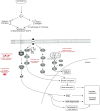Improving the outcome of patients with castration-resistant prostate cancer through rational drug development
- PMID: 16983403
- PMCID: PMC2360544
- DOI: 10.1038/sj.bjc.6603223
Improving the outcome of patients with castration-resistant prostate cancer through rational drug development
Abstract
Castration-resistant prostate cancer (CRPC) is now the second most common cause of male cancer-related mortality. Although docetaxel has recently been shown to extend the survival of patients with CRPC in two large randomised phase III studies, subsequent treatment options remain limited for these patients. A greater understanding of the molecular causes of castration resistance is allowing a more rational approach to the development of new drugs and many new agents are now in clinical development. Therapeutic targets include the adrenal steroid synthesis pathway, androgen receptor signalling, the epidermal growth factor receptor family, insulin growth factor-1 receptor, histone deacetylase, heat shock protein 90 and the tumour vasculature. Drugs against these targets are giving an insight into the molecular pathogenesis of this disease and promise to improve patient quality of life and survival. Finally, the recent discovery of chromosomal translocations resulting in the upregulation of one of at least 3 ETS genes (ERG, ETV1, ETV4) may lead to novel agents for the treatment of this disease.
Figures


Similar articles
-
Interaction between docetaxel resistance and castration resistance in prostate cancer: implications of Twist1, YB-1, and androgen receptor.Prostate. 2013 Sep;73(12):1336-44. doi: 10.1002/pros.22681. Epub 2013 Jun 14. Prostate. 2013. PMID: 23775496
-
Androgen receptor signalling impairs docetaxel efficacy in castration-resistant prostate cancer.Br J Cancer. 2020 Dec;123(12):1715-1719. doi: 10.1038/s41416-020-01105-y. Epub 2020 Sep 29. Br J Cancer. 2020. PMID: 32989230 Free PMC article.
-
Novel agents for the management of castration-resistant prostate cancer.Curr Opin Urol. 2012 May;22(3):175-82. doi: 10.1097/MOU.0b013e3283523ba0. Curr Opin Urol. 2012. PMID: 22472509 Review.
-
Androgen Receptor Targeted Treatments of Prostate Cancer: 35 Years of Progress with Antiandrogens.J Urol. 2018 Nov;200(5):956-966. doi: 10.1016/j.juro.2018.04.083. Epub 2018 May 3. J Urol. 2018. PMID: 29730201 Review.
-
Phase II study of cytarabine in men with docetaxel-refractory, castration-resistant prostate cancer with evaluation of TMPRSS2-ERG and SPINK1 as serum biomarkers.BJU Int. 2012 Sep;110(6):840-5. doi: 10.1111/j.1464-410X.2011.10922.x. Epub 2012 Feb 7. BJU Int. 2012. PMID: 22313860 Clinical Trial.
Cited by
-
Personalization of prostate cancer prevention and therapy: are clinically qualified biomarkers in the horizon?EPMA J. 2012 Jan 12;3(1):3. doi: 10.1007/s13167-011-0138-2. EPMA J. 2012. PMID: 22738151 Free PMC article.
-
Monascuspiloin enhances the radiation sensitivity of human prostate cancer cells by stimulating endoplasmic reticulum stress and inducing autophagy.PLoS One. 2012;7(7):e40462. doi: 10.1371/journal.pone.0040462. Epub 2012 Jul 3. PLoS One. 2012. PMID: 22802963 Free PMC article.
-
The changing therapeutic landscape of castration-resistant prostate cancer.Nat Rev Clin Oncol. 2011 Aug 9;8(10):597-610. doi: 10.1038/nrclinonc.2011.117. Nat Rev Clin Oncol. 2011. PMID: 21826082 Review.
-
PSMA-targeted polyinosine/polycytosine vector induces prostate tumor regression and invokes an antitumor immune response in mice.Proc Natl Acad Sci U S A. 2017 Dec 26;114(52):13655-13660. doi: 10.1073/pnas.1714587115. Epub 2017 Dec 11. Proc Natl Acad Sci U S A. 2017. PMID: 29229829 Free PMC article.
-
Significant and sustained antitumor activity in post-docetaxel, castration-resistant prostate cancer with the CYP17 inhibitor abiraterone acetate.J Clin Oncol. 2010 Mar 20;28(9):1489-95. doi: 10.1200/JCO.2009.24.6819. Epub 2010 Feb 16. J Clin Oncol. 2010. PMID: 20159823 Free PMC article. Clinical Trial.
References
-
- Ayala G, Thompson T, Yang G, Frolov A, Li R, Scardino P, Ohori M, Wheeler T, Harper W (2004) High levels of phosphorylated form of Akt-1 in prostate cancer and non-neoplastic prostate tissues are strong predictors of biochemical recurrence. Clin Cancer Res 10: 6572–6578 - PubMed
-
- Banerji U, O’Donnell A, Scurr M, Pacey S, Stapleton S, Asad Y, Simmons L, Maloney A, Raynaud F, Campbell M, Walton M, Lakhani S, Kaye S, Workman P, Judson I (2005) Phase I pharmacokinetic and pharmacodynamic study of 17-allylamino, 17-demethoxygeldanamycin in patients with advanced malignancies. J Clin Oncol 23: 4152–4161 - PubMed
-
- Beer TM, Myrthue A, Eilers KM (2005) Rationale for the development and current status of calcitriol in androgen-independent prostate cancer. World J Urol 23: 28–32 - PubMed
-
- Berthold DR, Sternberg CN, Tannock IF (2005) Management of advanced prostate cancer after first-line chemotherapy. J Clin Oncol 23: 8247–8252 - PubMed
Publication types
MeSH terms
Substances
Grants and funding
LinkOut - more resources
Full Text Sources
Other Literature Sources
Medical
Research Materials

